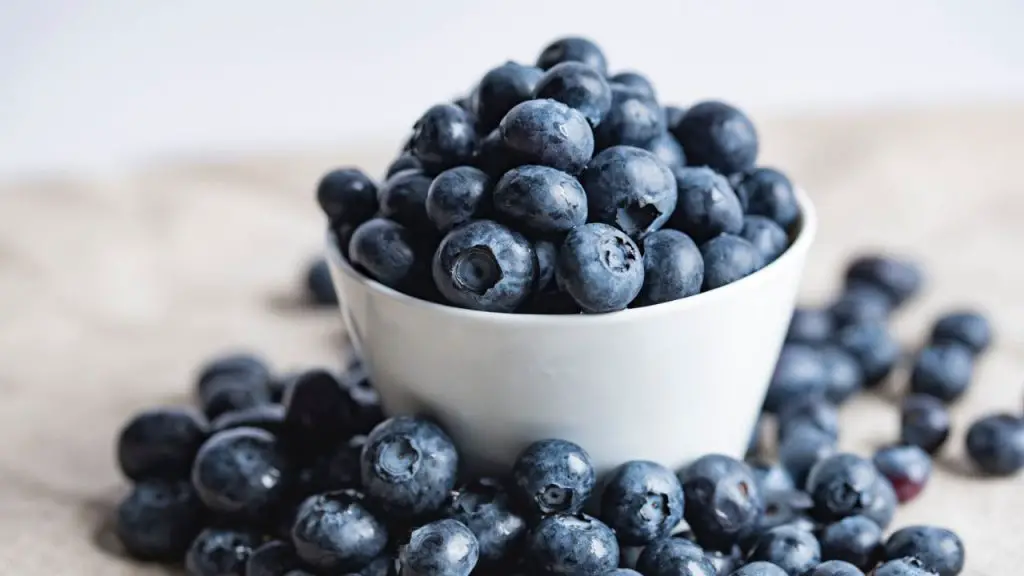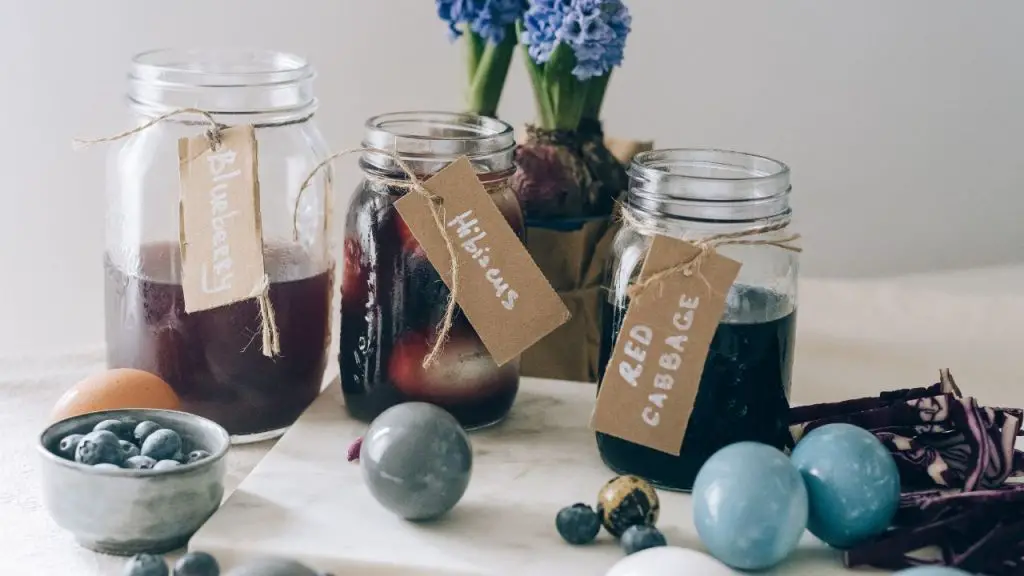You’ve heard of mead.
It’s the oldest alcoholic beverage in the world.
People have been making it for centuries and even figured out how to make different kinds, like blueberry mead.
To easily make this, ferment honey, yeast, and water with blueberry for 3 to 6 weeks.
But if you’re new to fermentation, we suggest starting small.
Here’s a recipe to help you make blueberry mead at home.
Let’s get started!

Mead 101
Do you know what mead is?
It’s like wine, but it’s made with honey instead of fruit.
This recipe is technically a melomel, a mead with fruit added.
But people usually call it mead.
Ingredients
Main Ingredients
- Honey (2-3 lbs., depending on desired sweetness)
- Raisins or yeast nutrient (1/8 cup)
- Non-chlorinated or filtered water (1 gallon)
- Blueberries (1-2 lbs., fresh or frozen)
- Champagne yeast or other wine yeast (1/2 packet)
- Vanilla bean (sliced lengthwise, optional)
- Cinnamon stick (optional)
Brewing Equipment
- Long-handled wooden spoon or ladle
- Fermentation airlock
- 1-gallon glass carboy with a lid or fermenting bucket
- Large funnel
- Large stockpot
- Thermometer
- Hydrometer (optional)
- Straining bag (optional)
- Masher (optional)
Sanitizing
- Mixing bowl
- Bottle cleaning brush
- Unscented dishwashing soap
- Hot water
- Sanitizing solution
Bottling Equipment
- Tubing and auto siphon
- Glass bottles with flip-top lids
Consider brewing and tasting Kombucha Beer.
Using Blueberries
You can choose between fresh or frozen blueberries.
However, there may be a few things to consider.
Fresh blueberries require more prep, while frozen ones are ready to go.
Keep this in mind when deciding which to use.
Fresh Blueberries
Be sure to use fresh, ripe blueberries.
Check for any that are not ripe or moldy.
Chop the blueberries and let them in honey for a couple of hours. T
his is called maceration, and it draws out the juices from the berries.
Discover and consider sampling Viking Mead.
Frozen Blueberries
You don’t need to macerate if you’re using frozen blueberries.
Just freeze and thaw them – it’ll break them down and give you a result similar to maceration.
Instructions
Sanitizing Everything
It would be best to start by sanitizing all the tools and equipment you’ll use to make the mead.
It’s essential to ensure everything is clean to stop bacteria from growing.
- Use hot water and unscented dishwashing soap to scrub the stockpot, carboy, bottles, and utensils.
- Then, rinse them off. Next, mix the sanitizer and water in a bowl according to the instructions on the label.
- Finally, use the sanitizing solution to clean everything.
Making the Must
Mixing honey and water is called a must.
Generally, it’s three pounds of wildflower honey for each gallon of water.
Feel free to adjust to your taste.
Remember, using less honey will make your mead dry.
- Heat half a gallon of non-chlorinated or filtered water in a big pot.
- Once it’s warm but not boiling, turn off the heat.
- Stir in the honey with a long wooden spoon.
- If it’s hard to pour, try soaking the container in hot water or putting it in the oven at 100°F. This should help the honey dissolve quickly.
- Let it sit for about 10 minutes or so to cool.
Adding Fruit and Yeast Nutrients
The recipe requires adding fruits and raisins (or yeast nutrients) to your blueberry mead.
You can use either a glass carboy or a fermenting bucket.
One-gallon Glass Carboy
Put the ripe blueberries we talked about earlier in the carboy.
Don’t use any that are moldy or of low quality.
Don’t put it in your mead if you wouldn’t eat it.
Take off the stems and leaves, then clean the fruit.
The berries you use for your blueberry mead recipe can be fresh or frozen.
Both work well but remember that the preparation process is slightly different.
Maceration for fresh, while freezing, and thawing for frozen.
You can revisit what we talked about earlier for more information.
- Add cinnamon and vanilla to the carboy for extra flavor (optional).
- Throw in some raisins for natural yeast nutrients.
- If you’d rather, you can use yeast nutrients from the store.
- Use a funnel to pour the warm honey-water mixture into the jug.
- Top it off with the other half gallon of non-chlorinated or filtered water, leaving two inches of headspace.
- Finally, put the lid on and give it a light mix.
Fermenting Bucket
- Put the blueberries directly into the fermenting bucket or use a straining bag.
- Gently mash the fruits with a masher or spoon to release their juices.
- You can add flavorings, raisins, or yeast nutrients if you like.
- Pour the warm must over the fruits in the bucket.
- Add the remaining half a gallon of non-chlorinated or filtered water.
- Stir the mixture gently.
- If you have a hydrometer, you can take a gravity reading to determine the mead’s alcohol percentage. This step is optional.
Pitching the Yeast
It’s time to start fermenting!
Yeast is essential for turning honey and other ingredients into mead.
It’s the yeast that converts the sugar in honey into alcohol.
So, it’s essential to pick the suitable yeast.
Consider its alcohol tolerance and temperature range.
Popular yeast choices for mead include champagne yeast (Lalvin EC-1118) and white wine yeast (Lalvin D-47).
- Check the temperature of your must with a thermometer. It should be between 60-90°F.
- Put half the yeast packet into the must and shake or stir it to spread it evenly.
- Follow the package instructions to rehydrate the yeast.
Airlock Time
- Put the lid back on, add the airlock, and you’re ready to ferment. It usually takes 12 to 24 hours for the bubbles to show up, which means it’s working.
- Keep the jug in an excellent dark spot away from the sun.
- Then, remove the airlock and rinse it off to keep it clean.
Mead Bottling Time
It usually takes three to six weeks for the mead to ferment.
You’ll know it’s ready to bottle when the airlock has no more bubbles and the mead has cleared.
First, you have to:
- Sanitize your bottling tools first.
- Attach one end of the tube to the auto-siphon and the other to the bottle.
- Flip-top lids are easy to cap and reusable.
- Carefully transfer the mead from the fermenting jug to the bottle, avoiding the sediments at the bottom.
Enjoy your mead from the bottle, or let it age for more flavor.
With this recipe, the blueberry mead improves with age and can continue to ferment even after bottling.
Blueberry Mead Recipe Variations

Experiment with this blueberry mead recipe to make it your own!
Try adding different flavors to make it just right for you.
Here are some ideas:
Wildflower Honey
You might usually prefer neutral honey, but wildflower honey brings out this mead’s blueberry flavor.
It’s much better than other honey types that could overpower the blueberry.
Clementines
You’ll love this variation!
Add the juice and peel off a few clementines when heating the mixture.
It works well with blueberries and mead in general.
It’s a great combination!
Learn the obscurity brewing and craft mead in this blog post.
Final Thoughts
You may find it tricky to tell when your mead fermentation is complete.
You could have steady bubbles for weeks, but the sample may taste too sweet.
Use a hydrometer to test the gravity and sugar content.
Make sure the yeast you add is active and healthy.
You can also pitch in new yeast with a yeast nutrient from the store.
It’s a small batch, so it’s perfect for first-time brewers.
No need to be intimidated – it’s simpler than other mead recipes.
Give it a try in the comfort of your own home!
Other related articles to read are:
The Basics In Making Distilled Mead.